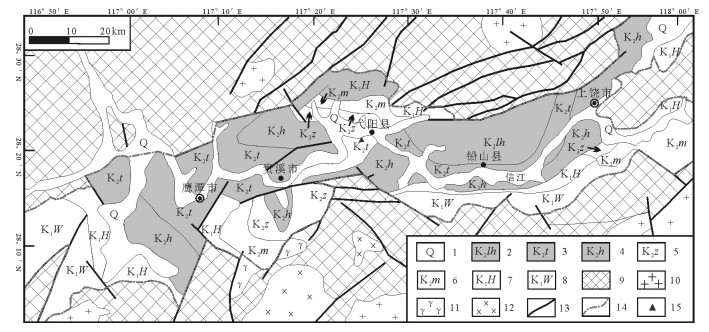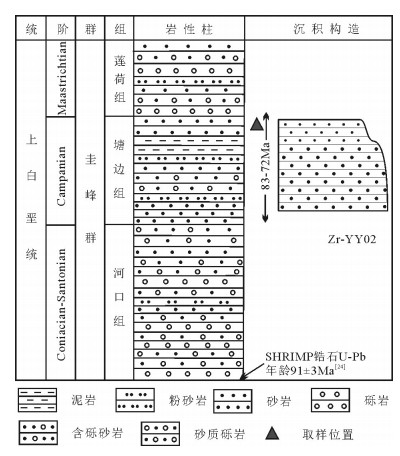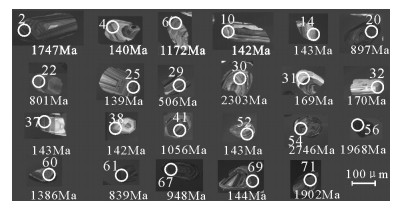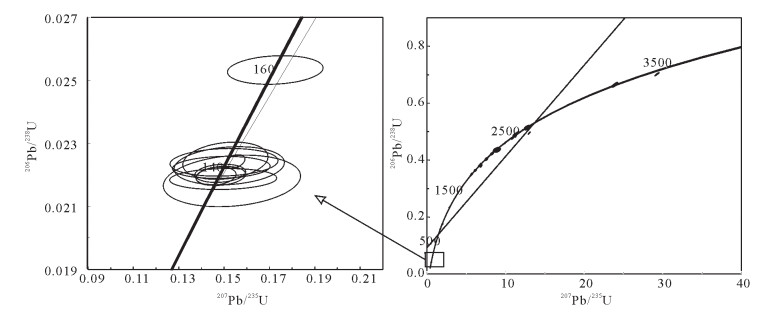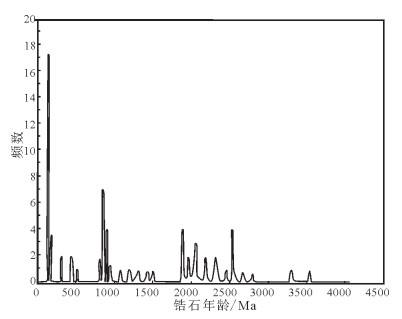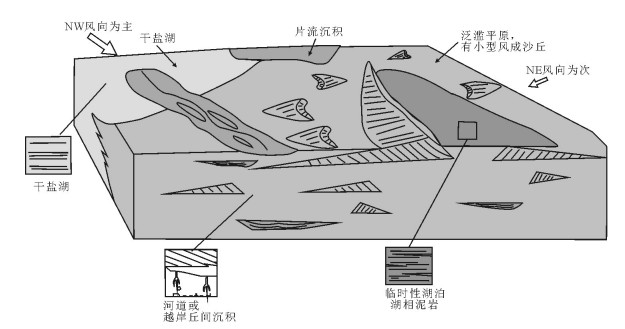Detrital zircon U-Pb dating of the Late Cretaceous aeolian sandstones from the Tangbian Formation in the Yiyang area of Jiangxi Province and its provenance significance
-
摘要:
赣东北信江盆地晚白垩世圭峰群塘边组以发育大型高角度交错层理的风成砂岩为特征,总体为干旱气候条件下沙漠沉积环境的产物。该地区所采砂岩样品为紫红色中-细粒长石石英砂岩,碎屑颗粒主要包括石英、长石、云母和岩屑,多呈次圆状,分选性较好。利用碎屑锆石LA-ICP-MS测年法,对塘边组风成砂岩进行U-Pb同位素定年,分析物源。碎屑锆石颗粒大多数大于100μm,Th/U值为0.1~2.1,且大部分锆石内部具有清晰的振荡环带结构,表明多数为岩浆锆石。206Pb/238U年龄加权平均值为141.4±1.2Ma。锆石U-Pb年龄主要集中于5个年龄段,分别是137~170Ma、431~506Ma、798~1172Ma、1268~2493Ma、2501~3488Ma。这些主要年龄区间与中国东南地区已知的岩浆事件对应,分别为燕山运动、加里东运动、晋宁运动、吕梁运动。其中,燕山期酸性火山-侵入杂岩提供了主要物源。结合风成砂岩交错层理反映的古风向数据,认为弋阳塘边组碎屑物质主要来自盆地北西部的九岭地区及北东部地区。
Abstract:The Tangbian Formation of the Late Cretaceous Guifeng Group in the Xinjiang Basin of northeastern Jiangxi Province is characterized by large-scale cross-bedded sandstones. They are generally products of a desert depositional environment under arid climate. The sandstone samples are purple red, fine-to medium-grained feldspar quartz sandstones. Sand particles are mainly composed of quartz, feldspar, mica and rock fragments, which are subangular to subrounded and well sorted. In order to analyze the source rocks of the Tangbian Formation, LA-ICP-MS zircon U-Pb analysis was performed. The zircon grains are mostly larger than 100μm. The results show that the Th/U ratios range from 0.1 to 2.1, and most of the zircons have a clear internal shock band structure, indicating that most of them were magmatic zircons. The mean age of 206Pb/238U is 141.4±1.2Ma. The age of zircon U-Pb ages are mainly concentrated in five zones of 137~170Ma, 431~506Ma, 798~1172Ma, 1268~2493Ma, 2501~3488Ma, corresponding to the major magmatic events in Southeast China, namely Yanshanian, Caledonian, Jinning, and Lvliang movements, with the Yanshanian volcanic-intrusive complex providing the dominant sediments. In combination with the paleo-wind directions from the aeolian sandstones, the sediments are interpreted to be largely from the northwestern Jiuling mountain area and the northeastern areas.
-
Keywords:
- detrital zircon /
- Late Cretaceous /
- Tangbian Formation /
- aeolian sandstone /
- Xinjiang Basin
-
柴达木盆地为青藏高原北缘最大的山间盆地[1-2],随着高原的隆升,自新生代以来沉积了周缘造山带剥落的巨厚碎屑沉积物。长期以来,学者们对青藏高原的研究多围绕东部、南部和高原内部区域进行,关于其隆升历史的认识主要来自地层沉积速率变化和Ar-Ar定年、裂变径迹低温热年代学方法,对盆地尤其是柴达木盆地新生代沉积物与高原和毗邻山脉的制约关系涉及较少[3-5]。沉积物作为连接盆地和剥蚀源区的纽带,准确记录了印度和欧亚板块碰撞过程中周缘造山带的构造活动及隆升过程[6-9]。另一方面,沉积物在搬运、堆积过程中,成分受环境和气候影响小,且不受地域构造热事件的约束,可以作为洞悉盆山耦合过程及相互作用的理想载体。对柴达木盆地沉积物源追踪及特征的研究,是反演和认识高原北缘构造隆升历程的有效途径,有助于解决整个青藏高原的隆升问题。
本文以柴达木盆地北缘露头较好、年代精确、新生代地层连续的路乐河地区沉积剖面为研究对象,应用阴极发光技术,通过标志性碎屑组分变化的对比和系统的物源分析,识别路乐河地区对周缘造山带的响应沉积,有效界定青藏高原北缘构造运动和隆升事件的时限,为进一步科学认识高原演化、隆升历史及板块碰撞远程效应提供重要线索。
1. 地质概况
路乐河地区位于柴达木盆地的北缘,在大地构造位置上,东北毗邻祁连山-南山,西北靠近赛北逆冲断裂[10]和略远的阿尔金左行走滑断裂带[11-12],南端远离东昆仑山脉(图 1-a)。受南特提斯洋盆的俯冲消减及印度-欧亚碰撞远程效应的影响,柴达木盆地及邻接造山带经历了多期次的重大构造地质事件[13-17]。路乐河地区也沉积了巨厚的新生代岩层,记录着盆地接纳沉积物填充过程中山脉隆升与环境变化的演化信息,能够为研究青藏高原北缘造山带的隆升增添佐证。路乐河地区地层从底到顶依次为白垩系犬牙沟组(K1q)、古新统—始新统路乐河组(E1+2l)、始新统下干柴沟组(E2g)、渐新统上干柴沟组(E3g)、中新统下油砂山组(N1y1)和上油砂山组(N1y2),以及中新统—上新统狮子沟组(N1+2s)共7套地层(图 1-b)[18]。其中路乐河组与犬牙沟组呈角度不整合接触,下、上油砂山组界线不明显,文中并称为油砂山组。
据马海幅1:20万区域地质调查报告①,赛什腾山主要岩性有浅变质千枚岩和绢云母片岩、碎屑岩及大量花岗岩类,并含少量安山岩、玄武岩等中基性喷出岩。南祁连山以古元古界片麻岩和大理岩深变质岩系、石炭系和三叠系碎屑岩、碳酸盐岩及达肯大坂地区达肯大坂群的斜长片麻岩和变质石英岩为主,出露岩浆岩主要为加里东期和海西期花岗岩、奥陶纪和志留纪中酸性火山岩。阿尔金山脉主要出露中、新元古界及少量奥陶系[19-20],中元古界岩性为变质碎屑岩、碳酸盐岩,发育少量玄武岩-安山岩-流纹岩组合,蓟县系出露些许闪长岩、花岗岩等侵入岩;新元古界和奥陶系均由碎屑岩和碳酸盐岩组成,火山岩不发育;新元古界变质岩系分布较多,由变质砂岩、斜长变粒岩、角闪片岩及结晶灰岩构成。
2. 碎屑矿物阴极发光特征
2.1 阴极发光原理
在外部能量的激发下,多数绝缘矿物会发生光子辐射。当激发源为高能电子束时,矿物发射可见光波段的光子,即为阴极发光(Cathodolumines-cence)[21]。矿物阴极发光根本上是由晶格中的微量元素或固有缺陷激发引起的,这些元素和晶格缺陷统称为发光中心(Luminescence centers)[22]。晶格中发光中心含量越高、越密集,矿物阴极发光的强度越强[23]。碎屑岩中不同类型的矿物颗粒,像石英、长石等,以及不同成因的矿物晶体,如喷出型石英和侵入型石英,由于其内部结构、元素组成各不相同,其阴极发光的颜色和强度也有所差别,因此阴极发光可以很好地指示沉积岩碎屑成分,这已为多数学者认同[24-29]。
2.2 阴极发光特征
石英是碎屑岩中含量最高的造岩矿物,传统的碎屑组分统计方法将其简单地划分为单晶石英和多晶石英,忽略了石英不同成因及来源的深层次信息。一般而言,蓝紫色、深蓝色-蓝色为岩浆岩石英,棕色、深棕褐色阴极光为变质型来源(图版Ⅰ-A、B)。由于石英重结晶过程中微量元素和晶格缺陷重新调整,或变形强烈造成高密度的发光中心,能量激发时声子发射(能量热)代替光子发射,从而降低了发光强度[30-31]。长石也是碎屑岩中常见的造岩矿物,在长距离搬运过程中易发生破裂、溶解,故长石含量的高低可以作为岩石风化强度和搬运距离的量化指标。如图版Ⅰ-B、C所示,斜长石阴极发光显示天蓝色、灰蓝色、黄绿色和少量黄色,微斜长石发黄灰色阴极光,其中亮蓝色为碱性长石(钙长石、钾长石),钙长石因Fe2+的存在呈芥末黄色、灰蓝色,酸性更长石以黄绿色居多[24, 32-33]。
![]() 图版ⅠA.岩浆型石英(Q1)、变质型石英(Q2)阴极发光特征;B.碳酸盐岩(Lsc)阴极发光特征;C.不同类型长石(K为微斜长石,P为长石)阴极发光特征;D.泥岩(Ls)阴极发光特征;E.变质石英岩(Lm)及碳酸盐胶结世代(C1、2)阴极发光特征;F.千枚岩-片岩(Lm)、花岗岩(Lg)阴极发光特征;G.喷出岩(Lv)阴极发光特征(图片据参考文献[36]);H.路乐河砂岩砾石组分特征图版Ⅰ.
图版ⅠA.岩浆型石英(Q1)、变质型石英(Q2)阴极发光特征;B.碳酸盐岩(Lsc)阴极发光特征;C.不同类型长石(K为微斜长石,P为长石)阴极发光特征;D.泥岩(Ls)阴极发光特征;E.变质石英岩(Lm)及碳酸盐胶结世代(C1、2)阴极发光特征;F.千枚岩-片岩(Lm)、花岗岩(Lg)阴极发光特征;G.喷出岩(Lv)阴极发光特征(图片据参考文献[36]);H.路乐河砂岩砾石组分特征图版Ⅰ.岩屑是母岩机械破碎的产物,继承了母岩岩性和岩石的结构特征,可直接反映物源区的岩石类型及岩性组合[34-35]。常见的岩屑类型有沉积岩、变质岩和岩浆岩。沉积岩岩屑含泥岩、碳酸盐岩等;泥岩岩屑不具阴极发光,但内部显示大量无规则的蓝色石英斑点(图版Ⅰ-D),识别标志独特,碳酸盐岩阴极发光颜色主要为亮黄色和橙红色色调,且可观察到碎屑颗粒至少经历了2期世代的碳酸盐胶结作用(图版Ⅰ-B、E)。路乐河碎屑组分变质岩岩屑含量较高,主要为千枚岩-片岩和石英岩。千枚岩-片岩岩屑与泥岩相似,表面含蓝色和棕色阴极光斑点,但其微定向排列的特点及规则外形易于被甄别(图版Ⅰ-A、F)。石英岩由砂岩和硅质岩经区域变质或接触变质作用形成,由多个亚石英晶粒构成,颗粒之间呈镶嵌接触,阴极发光呈棕色和部分蓝色(图版Ⅰ-E),前者表示其经历了高级变质重结晶作用[26]。侵入岩岩屑以花岗岩岩屑最常见,阴极发光下,花岗岩岩屑亦可见典型的花岗结构(图版Ⅰ-A、F),矿物颗粒明显;酸性喷出岩基质阴极发光呈血红色,石英斑晶不发光,两者界线截然(图版Ⅰ-G)。
3. 分析结果及物源指示
盆地沉积物主要由周缘造山带基岩经抬升剥蚀、搬运堆积形成,碎屑成分变化可以间接反映母岩或物源区的改变[37]。另外,沉积序列中特征岩石组分的出现标志着毗邻造山带隆升活动的启动[38-39]。依据上述不同矿物及岩屑类型的阴极发光特征,共完成了50件碎屑岩薄片组分的统计。统计工作在中国石油华北油田勘探开发研究院生油实验室完成,样品分布于各个层组,并对特征矿物和岩屑含量垂向序列变化进行了比较。
3.1 碎屑组分变化
沉积碎屑组分变化是反映盆地物源演化历程的重要物质表现。值得注意的是,单种碎屑成分的突然出现或消失,可以解释为构造运动造成源区物质组成的改变,再者出露地层被剥蚀殆尽所致。通过对比发现(图 2),新生代53.5~2.9Ma期间,路乐河沉积碎屑组分垂向上有3次明显的阶段性波动。第一次急剧变化发生在路乐河组中部,时间为50.1~46.6Ma,石英、长石及火山岩岩屑含量均保持在最低水平,石英岩岩屑达到峰值。盆地沉积物的高速率堆积与高原造山带的隆升相对应[41],暗示路乐河源区山脉经历了相对短暂的快速隆升剥蚀事件。在路乐河组与下干柴沟组交界(约44.5Ma),以云母和黄绿色长石首次大量出现及火山岩岩屑消失为标志,为路乐河地区沉积物源的第二次转换事件,碳酸盐岩和变质岩岩屑含量也急剧降低。云母主要赋存于花岗岩类或低级变质岩中,故云母的出现表征了物源区上述岩石的大面积暴露。第三次显著变化位于上干柴沟组顶部,时间为22.6Ma左右,黄绿色长石、碳酸盐岩和变质岩岩屑突增,变质型石英也呈增加趋势。概略地说,在50.1~46.6Ma、44.5Ma和22.6Ma前后,路乐河物源区可能爆发了剧烈的构造活动,致使路乐河地区沉积物组分发生阶段性变化。
![]() 图 2 路乐河地区物源转换事件与全球气候变化图(δ18O据参考文献[40])Figure 2. Transformation events in Lulehe and global climatic changes during the Cenezoic period
图 2 路乐河地区物源转换事件与全球气候变化图(δ18O据参考文献[40])Figure 2. Transformation events in Lulehe and global climatic changes during the Cenezoic period3.2 物源分析
河流是沉积物搬运的主要载体,古水流流向或优势流向的识别,有助于判别物源方位、追溯源区[42]。自古新世以来,柴达木盆地一直是一个内流汇水盆地[43-44],古水系[10]和物源恢复显示(图 3),路乐河地区新生代水流方向变化稳定,主体方位为SW向。此外,在路乐河地区除50.1~46.6Ma整个新生代沉积期外,碎屑矿物长石含量较高,平均为24.3%,其母岩类型应以含长石丰富的花岗岩或花岗片麻岩类为主[45-46],这同野外见到大量花岗岩及片麻岩砾石成分的事实一致(图版Ⅰ-H)。高长石含量的特征反映碎屑岩成分成熟度低,地层为干旱气候条件近物源快速搬运堆积形成。结合古水流方向和沉积物源方向可知(图 3),路乐河沉积体系主要受NE向南祁连和赛什腾造山带的供给制约,其沉积碎屑组分的3次变化分别表征物源的3次转变事件。
![]() 图 3 柴达木盆地新生代物源及古水流变化②Figure 3. The change of provenance and paleocurrent in Qaidam basin during the Cenozoic period
图 3 柴达木盆地新生代物源及古水流变化②Figure 3. The change of provenance and paleocurrent in Qaidam basin during the Cenozoic period(1)从犬牙沟组顶部到50.1Ma,各造岩矿物(长石、石英)及岩屑组分(石英岩、火山岩等)稳定沉积。通过对比赛什腾和南祁连山的岩性发现,变质石英岩、酸性火山岩和碳酸盐岩仅在南祁连山发育,因此路乐河此阶段物源区主要为南祁连山。50.1~46.6Ma,石英岩含量急增,表明南祁连可能经历过加速隆升事件[41],隆升引起变质岩基高速剥蚀,进而石英岩岩屑含量增大,其余组分则大幅减少。46.6Ma之后,碎屑组分恢复至50.1Ma之前的状态,南祁连山构造趋于稳定。
(2)44.5Ma,云母的发育表征了花岗岩类或含云母低级变质岩的大面积暴露,这与赛什腾山岩性一致,表明南祁连山不再是路乐河物源的主要供给者;另一方面,酸性火山岩岩屑的消失也指示路乐河的主要物源区由南祁连山向赛什腾山转变,石英岩和碳酸盐岩岩屑含量逐渐减少至消失亦印证了这一观点。
(3)22.6Ma前后,路乐河物源区再次发生转变。云母的稳定沉积及千枚岩-片岩的出现,反映赛什腾山持续为路乐河供给物源,而石英岩和碳酸盐岩岩屑的重新发育,表明南祁连山也开始为路乐河地区提供大量碎屑物质。变质岩贡献比例的加强,使岩浆型和变质型石英分别呈缩减和增加趋势。
4. 物源转换对构造隆升的响应
造山带的隆升和盆地的沉积是一个耦合过程,气候变化和构造运动对青藏高原隆升均具有一定的影响,如构造隆升促进化学风化作用的增加[47-48],造成大量基岩的脱落和搬运堆积;气候异常引起的快速侵蚀卸载作用造成山体总质量的亏缺,进而发生重力均衡效应[49],迫使山体抬升。但在长时间和大空间尺度上,构造运动对地体抬升的制约更甚于气候变化的影响[50-53],且构造活动的强弱程度能够由山脉剥蚀量或物源区岩性的变化直接体现[54]。与此同时,始新世早—中期和中新世早期全球气候变化趋于稳定(图 2),因此气候条件对路乐河地区新生代物源变化的影响可不予考虑。
(1)50.1~46.6Ma构造隆升响应
早在65~55Ma,印度和欧亚板块就已发生拼贴碰撞[12, 55-57],并在55~45Ma达到高峰[58],陆内拉萨、羌塘等刚性块体远程传递两大板块汇聚的强劲应力,隆升活动也同步传达到了高原北部地区[59-61]。现有柴达木和河西走廊地层学资料显示,阿尔金断裂起始于古新世49Ma[12],柴盆北缘的赛北断裂带及柴北缘断裂带在54.8~49Ma开始形成[10]。Jo-livet等[62]通过片麻岩磷灰石热模拟研究发现,祁连山在50Ma左右发生了快速的剥露事件,在路乐河剖面也曾报道51Ma存在一期高速率沉积[63]。从更大空间尺度看,青藏高原早期阶段的隆升在其他地区也有响应,如距高原较远的西南天山托云盆地新生代48.1±1.6Ma的幔源岩浆活动[64-65]和白垩纪—古近纪期间的托云块体旋转运动[66],可见青藏高原北缘构造变形活动相比印度-欧亚板块碰撞,滞后了约10±5Ma。以上研究均与南祁连山开始为路乐河地区提供大量剥蚀物的时限一致,揭示南祁连山50.1~46.6Ma的急剧抬升是对印度-欧亚板块碰撞的远程响应,也是碰撞应力在高原北部远程传递的有力证据。
(2)44.5Ma构造隆升响应
此时,印度与欧亚板块已完成全面碰撞,汇聚产生的应力推挤陆内已拼合的块体,使之横向缩短并相互叠置,引起陆内严重形变和逆冲推覆构造[67-68]。经热年代学研究[69],在当雄地区新厘定的纳木错逆冲推覆构造于古近纪44Ma经历过一次变形抬升事件,在高原腹地不同位置还发现大规模挤压型钾质-超钾质火山岩的踪迹[70-73],且在45~40Ma岩浆活动异常活跃。岩浆是板块碰撞挤压最直观的表现,区域性的岩浆侵位必将造成岩石圈增厚,高原整体性抬升[68, 74-75],在羌塘多格错仁地区新发现的埃达克岩表明,地壳在45~38Ma经历了缩短加厚[76]。然而,古地磁数据揭示[77],中始新世—早渐新世阿尔金主断裂和柴北缘断裂带山前沉积未发生明显的旋转变形,换言之,青藏高原新生代第二阶段的隆升以地壳垂向增生为主,具体表现为陆内块体南北向缩短、岩浆侵位和块体边界逆冲构造的发育。从44.5Ma开始,路乐河物源区由南祁连山向赛什腾山快速转变,表明赛北逆冲断裂伴随显著的隆升卸载作用,对应于高原内部的构造隆升事件。
(3)22.6Ma构造隆升响应
印度板块在中新世持续向大陆俯冲,逆冲构造以前展式推覆方式向前陆迁移、消减,形成一系列走滑-逆冲断裂和地层形变[67, 78]。来自五道梁雅西措组的古地磁结果显示,可可西里盆地在渐新世末期有29.1°±8.5°的顺时针垂轴旋转[79],赛北断裂山前地层有14°左右的移位[78]。George等[80]基于酒西盆地磷灰石裂变径迹分析,揭示出祁连山23Ma的快速隆升事件,Wang等[81]也获得了相同的冷却年龄。同时,西秦岭发生与高原隆升响应的构造-热事件,剥蚀速率急增[82],此次运动得到岩浆活动(22~23Ma)的证实[83-84],在高原内部也广泛存在相近年龄的火山喷发活动[85-89]。另一方面,在东昆仑山和阿尔金山前盆地也保留了中新世22Ma前后的岩浆活动、磨拉石沉积、断层平移、物源转型等隆升事件的地质记录[43, 62, 90-92],遥远的喀拉昆仑和西天山地区[93]亦发生与印度-欧亚板块碰撞相关的山体快速剥露事件。不言而喻,青藏高原在渐新世—中新世之交发生了大规模的构造运动,几乎波及整个高原。青藏高原整体性准同时隆升,进一步肯定了22.6Ma南祁连山与赛什腾山协同为路乐河供应沉积物的合理性。路乐河地区物源3次阶段性变化的认识也间接反映了青藏高原为阶段式隆升的观点[13, 67, 94-95]。
5. 结论
(1)沉积碎屑组分变化是反映盆地物源演化过程的重要物质表现。路乐河地区新生代碎屑组分高长石含量的特点,指示其为近物源搬运沉积形成。同时沉积物来源方向和周缘山系岩性对比揭示,路乐河物源主要受南祁连山和赛什腾山供给的控制。
(2)路乐河地区物源在新生代53.5~2.9Ma期间至少存在3次转换,发生时间同印度-欧亚板块碰撞及高原构造隆升事件吻合,间接反映了青藏高原为阶段式隆升的观点,时间依次为50.1~46.6Ma、44.5Ma和22.6Ma,深入认识青藏高原隆升历史及板块碰撞远程效应具有重要意义。
(3)44.5Ma之前,路乐河物源区主要为南祁连山,而50.1~46.6Ma南祁连山的快速抬升是对印度-欧亚板块初始碰撞应力的传递响应;青藏高原第二阶段的隆升以地壳垂向增厚为主,逆冲推覆构造发育,赛北断裂于44.5Ma发生显著的剥露作用,路乐河物源区由南祁连向赛什腾山转变;渐新世—中新世之交(22.6Ma),青藏高原准同时整体性隆升,赛什腾山和南祁连山协同为路乐河地区供应沉积物。
致谢: 东华理工大学硕士研究生王凤之、李余亮和李馨敏参加了野外工作,审稿专家提出了宝贵的修改意见,在此一并表示感谢。 -
图 1 信江盆地地质简图[6]和采样位置
1—第四系;2—莲荷组;3—塘边组;4—河口组;5—周田组;6—茅店组;7—火把山群;8—武夷群;9—前白垩系;10—侏罗纪-白垩纪花岗岩;11—三叠纪花岗岩;12—志留纪花岗岩;13—断层;14—盆地边界;15—采样位置
Figure 1. Simplified geological map of the Xinjiang Basin and the sampling location
表 1 江西弋阳塘边组风成砂岩样品碎屑锆石U-Th-Pb定年结果
Table 1 Detrital zircon U-Th-Pb dating results of the aeolian sandstone sample from the Tangbian Formation in the Yiyang area of Jiangxi Province
点号 Th U Pb 同位素比值 同位素年龄/Ma l0-6 Th/U 207Pb/206Pb 1 σ 207Pb/235U 1 σ 207Pb/238U 1 σ 208Pb/232Th 1 σ 207Pb/ 206Pb 1 σ 207Pb/235U 1 σ 206Pb/238U 1 σ 208Pb/232Th 1 σ 谐和度/% 01 33 25 59 1.34 0.1441 0.0025 8.4260 0.1273 0.4243 0.0038 0.1363 0.0014 2277 14 2278 14 2280 17 2583 25 100 02 148 514 581 0.29 0.0923 0.0013 3.2613 0.0356 0.2562 0.0016 0.0361 0.0010 1474 12 1472 8 1470 8 717 19 100 03 109 153 110 0.71 0.0701 0.0012 1.4988 0.0206 0.1552 0.0011 0.04744 0.00041 931 17 930 8 930 6 937 8 100 04 90 218 21 0.41 0.0484 0.0020 0.1465 0.0058 0.0220 0.0002 0.0072 0.0002 117 75 139 5 140 1 144 3 99 05 193 229 24 0.84 0.0490 0.0025 0.1485 0.0072 0.0220 0.0002 0.00737 0.00013 150 95 141 6 140 1 148 3 101 06 91 132 121 0.69 0.0790 0.0011 2.1703 0.0239 0.1993 0.0013 0.0615 0.0005 1172 12 1172 8 1172 7 1206 9 100 07 928 601 62 1.54 0.0496 0.0053 0.1523 0.0161 0.0223 0.0004 0.0066 0.0002 175 204 144 14 142 3 133 4 101 08 96 226 475 0.42 0.1554 0.0018 9.6558 0.0768 0.4509 0.0029 0.1222 0.0011 2406 6 2403 7 2399 13 2330 20 100 09 128 214 147 0.60 0.0692 0.0010 1.4320 0.0173 0.1501 0.0010 0.04786 0.00039 905 15 902 7 902 5 945 8 100 10 70 185 128 0.38 0.0693 0.0014 1.4299 0.0254 0.1497 0.0011 0.04456 0.0007 907 25 902 11 899 6 881 14 100 11 80 125 39 0.64 0.0557 0.0015 0.5544 0.0137 0.0722 0.0006 0.0218 0.0003 440 40 448 9 450 3 435 5 100 12 44 228 150 0.19 0.0682 0.0010 1.4111 0.0164 0.1500 0.0010 0.0476 0.0006 876 14 894 7 901 5 939 12 99 13 407 234 78 1.74 0.0558 0.0013 0.5323 0.0110 0.0692 0.0005 0.0207 0.0002 446 33 433 7 431 3 413 3 100 14 204 144 17 1.42 0.0487 0.0041 0.1506 0.0124 0.0225 0.0004 0.0072 0.0002 131 152 142 11 143 2 145 4 99 15 164 102 147 1.60 0.3683 0.0043 10.5716 0.0835 0.2083 0.0014 0.1503 0.0008 3784 5 2486 7 1219 7 2829 15 310 16 310 391 67 0.79 0.0494 0.0040 0.1726 0.0139 0.0253 0.0003 0.0074 0.0002 168 160 162 12 161 2 149 4 101 17 54 55 145 0.99 0.1772 0.0021 12.2875 0.1031 0.5030 0.0034 0.1548 0.0010 2627 6 2627 8 2627 14 2909 18 100 18 203 565 63 0.36 0.0488 0.0025 0.1483 0.0074 0.0221 0.0002 0.0077 0.0002 139 98 140 7 141 1 156 4 99 19 129 181 347 0.71 0.1262 0.0016 6.5246 0.0590 0.3750 0.0025 0.1089 0.0008 2046 8 2049 8 2053 11 2090 15 100 20 66 296 228 0.22 0.0693 0.0016 1.4249 0.0296 0.1492 0.0011 0.0479 0.0010 906 30 899 12 897 6 946 19 100 21 217 308 510 0.70 0.1145 0.0018 5.3249 0.0716 0.3375 0.0024 0.0751 0.0010 1871 14 1873 11 1875 12 1463 18 100 22 134 144 94 0.93 0.0663 0.0016 1.2091 0.0274 0.1322 0.0011 0.0347 0.0004 817 34 805 13 801 6 690 8 100 23 105 213 64 0.49 0.1650 0.0028 1.1776 0.0160 0.0518 0.0004 0.04212 0.00039 2508 13 790 7 325 2 834 8 119 24 45 50 125 0.89 0.1643 0.0020 10.7626 0.0912 0.4752 0.0031 0.1364 0.0010 2501 7 2503 8 2506 14 2585 18 100 25 230 285 26 0.80 0.0511 0.0068 0.1535 0.0200 0.0218 0.0005 0.00668 0.00029 243 248 145 18 139 3 135 6 104 26 42 216 374 0.19 0.1233 0.0014 6.2700 0.0443 0.3690 0.0022 0.13195 0.00103 2004 6 2014 6 2025 10 2505 18 99 27 180 149 708 1.21 0.2616 0.0036 23.7814 0.2710 0.6596 0.0060 0.28563 0.00268 3256 8 3259 11 3266 23 5078 42 100 28 114 182 444 0.62 0.1636 0.0018 10.7365 0.0767 0.4760 0.0029 0.1378 0.0009 2493 5 2501 7 2510 13 2609 15 99 29 150 162 63 0.92 0.0566 0.0018 0.6371 0.0190 0.0816 0.0007 0.0235 0.0003 476 51 500 12 506 4 470 7 99 30 71 107 247 0.66 0.1463 0.0055 8.5822 0.3166 0.4256 0.0061 0.0018 0.0029 2303 44 2295 34 2286 28 37 59 101 31 196 158 30 1.24 0.0502 0.0069 0.1839 0.0250 0.0266 0.0003 0.0075 0.0002 206 270 171 21 169 2 150 5 101 32 109 182 22 0.60 0.0496 0.0034 0.1830 0.0122 0.0268 0.0004 0.0084 0.0002 176 126 171 10 170 2 168 5 101 33 92 155 23 0.59 0.0496 0.0052 0.1496 0.0156 0.0219 0.0002 0.0031 0.0003 178 216 142 14 139 1 62 6 102 34 156 173 114 0.90 0.0675 0.0010 1.3128 0.0157 0.1412 0.0009 0.0415 0.0003 852 15 851 7 851 5 821 6 100 35 203 565 63 0.28 0.1450 0.0024 8.4615 0.1325 0.4233 0.0047 0.1024 0.0008 2288 13 2282 14 2275 21 1970 15 101 36 62 116 273 0.54 0.1643 0.0022 10.6118 0.1073 0.4685 0.0034 0.1276 0.1643 2501 $ 2490 9 2477 15 2427 25 101 37 150 272 37 0.55 0.0486 0.0051 0.1500 0.0157 0.0224 0.0003 0.0091 0.0486 127 211 142 14 143 2 183 6 99 38 123 204 31 0.60 0.0485 0.0047 0.1488 0.0142 0.0222 0.0002 0.0087 0.0485 125 196 141 13 142 1 174 7 99 39 100 405 655 0.25 0.1205 0.0016 5.8337 0.0566 0.3511 0.0023 0.1152 0.1205 1964 9 1951 8 1940 11 2203 24 101 40 177 205 77 0.86 0.2654 0.0045 1.8908 0.0255 0.0517 0.0004 0.0423 0.2654 3279 11 1078 9 325 3 838 7 143 41 259 338 281 0.76 0.0749 0.0009 1.8562 0.0167 0.1798 0.0011 0.0533 0.0749 1065 9 1066 6 1066 6 1050 6 100 42 150 400 1308 0.37 0.3034 0.0033 29.1938 0.1925 0.6979 0.0042 0.1781 0.3034 3488 5 3460 6 3413 16 3312 19 102 43 198 227 181 0.87 0.0676 0.0019 1.3088 0.0353 0.1404 0.0010 0.0403 0.0676 858 44 850 16 847 6 799 10 100 44 176 99 293 1.78 0.1795 0.0041 12.5054 0.2738 0.5054 0.0058 0.1301 0.1795 2648 21 2643 21 2637 25 2471 34 100 45 75 507 736 0.145 0.1132 0.0016 5.1941 0.0572 0.3328 0.0023 0.0871 0.1132 1852 10 1852 9 1852 11 1687 31 100 46 85 842 1018 0.10 0.1135 0.0015 5.2125 0.0542 0.3333 0.0024 0.0829 0.1135 1856 9 1855 9 1854 12 1611 109 100 47 109 92 82 1.18 0.2241 0.0032 4.8564 0.0540 0.1572 0.0012 0.08272 0.2241 3010 9 1795 9 941 7 1606 12 137 48 155 289 564 0.54 0.1336 0.0027 7.2298 0.1309 0.3926 0.0037 0.07060 0.1336 2146 19 2140 16 2135 17 1379 29 101 49 255 139 113 1.84 0.0700 0.0011 1.4937 0.0185 0.1549 0.0010 0.04361 0.0700 927 15 928 8 928 6 863 5 100 50 327 194 543 1.68 0.1663 0.0019 11.1392 0.0846 0.4859 0.0030 0.12162 0.1663 2521 6 2535 7 2553 13 2320 12 99 51 46 336 198 0.14 0.0664 0.0019 1.2053 0.0331 0.1317 0.0012 0.04420 0.0664 819 42 803 15 798 7 874 30 101 52 62 116 273 0.54 0.0501 0.0010 0.1549 0.0028 0.0224 0.0001 0.00669 0.0501 200 31 146 2 143 0.9 135 1 102 53 153 583 829 0.26 0.1510 0.0017 5.6001 0.0387 0.2690 0.0016 0.10823 0.00080 2357 5 1916 6 1536 8 2077 15 147 54 95 226 519 0.42 0.1904 0.0022 12.7502 0.0961 0.4858 0.0031 0.19463 0.00146 2746 6 2661 7 2552 13 3594 25 103 55 204 450 696 0.45 0.1290 0.0021 6.5451 0.0922 0.3682 0.0032 0.11391 0.00162 2084 13 2052 12 2021 15 2180 29 101 56 187 872 1241 0.21 0.1208 0.0018 5.8641 0.0698 0.3521 0.0026 0.01662 0.00314 1968 11 1956 10 1945 12 333 62 101 57 272 293 243 0.93 0.0664 0.0015 1.2520 0.0261 0.1368 0.0009 0.03832 0.00036 819 33 824 12 826 5 760 7 100 58 65 128 123 0.51 0.0830 0.0019 2.5038 0.0541 0.2190 0.0017 0.04200 0.00103 1268 30 1273 16 1276 9 832 20 99 59 89 129 281 0.68 0.1401 0.0026 7.9586 0.1347 0.4121 0.0036 0.09047 0.00227 2229 17 2226 15 2224 16 1751 ^2 100 60 37 149 161 0.25 0.0882 0.0013 2.8679 0.0324 0.2360 0.0015 0.06395 0.00105 1386 12 1374 8 1366 8 1253 20 101 61 85 400 266 0.21 0.0669 0.0015 1.2815 0.0269 0.1390 0.0010 0.03571 0.00092 834 32 838 12 839 6 709 18 100 62 113 182 439 0.62 0.1686 0.0019 11.0205 0.0735 0.4743 0.0028 0.12940 0.00072 2543 5 2525 6 2502 12 2460 13 102 63 258 276 146 0.93 0.3927 0.0059 3.8195 0.0431 0.0706 0.0006 0.07507 0.00059 3881 8 1597 9 440 4 1463 11 167 64 218 282 534 0.77 0.1350 0.0016 7.3403 0.0557 0.3945 0.0024 0.09912 0.00060 2164 6 2154 7 2144 11 1910 11 101 65 61 182 287 0.33 0.1178 0.0014 5.7077 0.0479 0.3516 0.0022 0.09974 0.00082 1923 7 1933 7 1942 10 1922 15 99 66 56 51 33 1.11 0.0669 0.0023 1.2191 0.0400 0.1323 0.0011 0.04183 0.00042 834 55 809 18 801 6 828 3 101 67 40 379 362 0.11 0.07136 0.0031 1.55796 0.06589 0.15839 0.00141 0.09396 0.00848 968 72 954 26 948 8 1815 157 101 68 52 87 81 0.59 0.16469 0.00289 3.59998 0.05342 0.15858 0.00134 0.09S74 0.0011 2504 14 1550 12 949 7 1903 20 119 69 276 509 53 0.54 0.04907 0.00194 0.15292 0.00582 0.02261 0.00018 0.00742 0.00014 151 74 144 5 144 1 149 3 100 70 197 144 45 1.37 0.0522 0.00326 0.34259 0.02111 0.04762 0.0004 0.01564 0.0002 294 127 299 16 300 2 314 4 100 71 57 310 446 0.18 0.11639 0.00149 5.47014 0.0516 0.34097 0.00222 0.09871 0.00117 1902 8 1896 8 1891 11 1903 22 101 72 103 241 44 0.43 0.04841 0.01218 0.14287 0.03587 0.02141 0.00034 0.00964 0.001 119 411 136 32 137 2 194 20 99 73 77 158 16 0.48 0.04949 0.00297 0.15368 0.00898 0.02253 0.00028 0.00721 0.00021 171 110 145 8 144 2 145 4 101 74 162 317 361 0.51 0.46979 0.0059 5.94982 0.05013 0.09188 0.00065 0.20098 0.00132 4149 6 1969 7 567 4 3702 22 165 75 115 183 245 0.63 0.2557 0.00323 6.62758 0.05893 0.18804 0.00128 0.18141 0.00123 3220 7 2063 8 1111 7 3370 21 118 76 107 439 634 0.24 0.11361 0.00151 5.30494 0.05363 0.33877 0.00226 0.07789 0.00098 1858 9 1870 9 1881 11 1516 18 99 77 123 405 252 0.30 0.06656 0.00131 1.29938 0.02258 0.14163 0.00104 0.04054 0.0006 824 24 845 10 854 6 803 12 99 78 714 327 869 2.19 0.16536 0.00315 10.91654 0.19558 0.47894 0.00538 0.10259 0.00092 2511 16 2516 17 2523 23 1974 17 100 79 134 1111 1977 0.12 0.12644 0.00217 6.51166 0.0975 0.37363 0.00313 0.00185 0.00211 2049 15 2047 13 2046 15 37 上3 100 80 159 375 81 0.42 0.21516 0.00356 0.89397 0.01176 0.03014 0.00023 0.03551 0.00031 2945 12 648 6 191 1 705 6 135 -
江西省地质矿产局.江西省区域地质志[M].北京:地质出版社, 1984. 巫建华.江西信江盆地早白垩世晚期轮藻及其地层意义[J].微体古生物学报, 1995, 12(1):79-87. doi: 10.2217-phe.09.69/ 江西省地质矿产厅.江西省岩石地层[M].武汉:中国地质大学出版社, 1997. 江新胜, 潘忠习, 徐金沙, 等.江西信江盆地晚白垩世风成沙丘的发现及其古风向[J].地质通报, 2006, 25(7):833-838. doi: 10.3969/j.issn.1671-2552.2006.07.010 Jiang X S, Pan Z X, Xu J S, et al. Late Cretaceous aeolian dunes and reconstruction of palaeo-wind belts of the Xinjiang Basin, Jiangxi Province, China[J]. Palaeogeography, Palaeoclimatology, Palaeoecology, 2008, 257(1):58-66. http://www.wanfangdata.com.cn/details/detail.do?_type=perio&id=4fdfc9852c03579aa1569eb848faac69
郭福生, 朱志军, 黄宝华, 等.江西信江盆地白垩系沉积体系及其与丹霞地貌的关系[J].沉积学报, 2013, 31(6):954-964. http://www.wanfangdata.com.cn/details/detail.do?_type=perio&id=cjxb201306002 Chen L Q, Steel R J, Guo F S, et al. Alluvial fan facies of the Yongchong Basin:Implications for tectonic and paleoclimatic changes during Late Cretaceous in SE China[J]. Journal of Asian Earth Sciences, 2017, 134:37-54. doi: 10.1016/j.jseaes.2016.10.010
陈留勤, 郭福生, 梁伟, 等.江西抚崇盆地上白垩统河口组砾石统计特征及其地质意义[J].现代地质, 2013, 27(3):568-576. doi: 10.3969/j.issn.1000-8527.2013.03.007 唐超, 陈留勤, 郭福生, 等.江西永丰-崇仁盆地上白垩统砾石岩性和磨圆度列联表分析及其对物源的指示[J].现代地质, 2014, 28(5):971-979. doi: 10.3969/j.issn.1000-8527.2014.05.012 陈留勤, 郭福生, 梁伟.赣杭构造带西段上白垩统河口组砂岩碎屑组成及物源区的构造属性[J].中南大学学报(自然科学版), 2015, 46(2):571-578. http://www.cnki.com.cn/Article/CJFDTOTAL-ZNGD201502027.htm Chen L Q, Guo F S, Steel R J, et al. Petrography and geochemistry of the Late Cretaceous redbeds in the Gan-Hang Belt, southeast China:implications for provenance, source weathering, and tectonic setting[J]. International Geology Review, 2016, 58(10):1196-1214. doi: 10.1080/00206814.2016.1141378
Chen L Q, Guo F S, Tang C. Evolution of the Late Cretaceous Yongfeng-Chongren Basin in Jiangxi Province, southeast China:insights from sedimentary facies analysis and pebble counting[J]. Journal of Mountain Science, 2016, 13(2):342-351. doi: 10.1007/s11629-014-3387-4
Fedo C M. Detrital Zircon Analysis of the Sedimentary Record[J]. Reviews in Mineralogy & Geochemistry, 2003, 53:277-303. doi: 10.2113-0530277/
Gehrels G. Detrital Zircon U-Pb Geochronology Applied to Tectonics[J]. Annual Review of Earth & Planetary Sciences, 2014, 42:127-149. http://cn.bing.com/academic/profile?id=cea9ca39e205614445261a151c1d2dc8&encoded=0&v=paper_preview&mkt=zh-cn
第五春荣, 孙勇, 王倩.华北克拉通地壳生长和演化:来自现代河流碎屑锆石Hf同位素组成的启示[J].岩石学报, 2012, 28(11):3520-3530. http://d.old.wanfangdata.com.cn/Conference/7863094 万浩章, 刘战庆, 刘善宝, 等.赣东北朱溪铜钨矿区花岗闪长斑岩LA-ICP-MS锆石U-Pb定年及地质意义[J].岩矿测试, 2015, (4):494-502. http://d.old.wanfangdata.com.cn/Periodical/ykcs201504021 郭佩, 刘池洋, 王建强, 等.碎屑锆石年代学在沉积物源研究中的应用及存在问题[J].沉积学报, 2017, 35(1):46-56. http://d.old.wanfangdata.com.cn/Periodical/cjxb201701005 张晓飞, 王必任, 张华川, 等.内蒙古西乌旗罕乌拉地区下二叠统寿山沟组碎屑锆石LA-ICP-MS U-Pb年龄及其地质意义[J].地质通报, 2018, 37(5):863-880. http://dzhtb.cgs.cn/gbc/ch/reader/view_abstract.aspx?file_no=20180510&flag=1 邹思远, 厉子龙, 任钟元, 等.塔里木柯坪地区二叠系沉积岩碎屑锆石U-Pb定年和Hf同位素特征及其对塔里木块体地质演化的限定[J].岩石学报, 2013, 29(10):3369-3388. http://d.old.wanfangdata.com.cn/Periodical/ysxb98201310005 高林志, 丁孝忠, 刘燕学, 等.江山-绍兴断裂带陈蔡岩群片麻岩SHRIMP锆石U-Pb年龄及其地质意义[J].地质通报, 2014, 33(5):641-648. doi: 10.3969/j.issn.1671-2552.2014.05.005 刘战庆, 刘善宝, 裴荣富, 等.赣东北珍珠山花岗岩脉地球化学、锆石U-Pb定年及Hf同位素组成研究[J].大地构造与成矿学, 2016, 40(4):808-825. http://d.old.wanfangdata.com.cn/Periodical/ddgzyckx201604014 Wang D Z, Shu L S. Late Mesozoic basin and range tectonics and related magmatism in Southeast China[J]. Geoscience Frontiers, 2012, 3(2):109-124. http://www.wanfangdata.com.cn/details/detail.do?_type=perio&id=dxqy-e201202002
舒良树.华南构造演化的基本特征[J].地质通报, 2012, 31(7):1035-1053. doi: 10.3969/j.issn.1671-2552.2012.07.003 李瑞玲, 李真真.中国东南部余江基性岩体的SHRIMP锆石UPb年龄及其地质意义[J].矿物岩石, 2010, 30(2):45-49. doi: 10.3969/j.issn.1001-6872.2010.02.009 巫建华, 项媛馨, 钟志菲.江西广丰-玉山盆地橄榄粗玄岩的SHRIMP锆石U-Pb定年和Sr-Nd-Pb-O元素同位素特征[J].岩石矿物学杂志, 2014, 33(4):645-656. doi: 10.3969/j.issn.1000-6524.2014.04.004 曹珂.中国陆相白垩系地层对比[J].地质论评, 2013, 59(1):24-40. doi: 10.3969/j.issn.0371-5736.2013.01.004 Timothy M, Kusky, Ye M H, et al. Geological Evolution of Longhushan World Geopark in Relation to Global Tectonics[J]. Journal of Earth Science, 2010, 21(1):1-18. http://d.old.wanfangdata.com.cn/Periodical/dqkx-e201001002
Zong K Q, Liu Y, Gao C, et al. In situ U-Pb dating and trace element analysis of zircons in thin sections of eclogite:Refining constraints on the ultra high-pressure metamorphism of the Sulu terrane, China[J]. Chemical Geology, 2010, 269(3):237-251. http://cn.bing.com/academic/profile?id=571270a581b5eb279753d9e332b58c2c&encoded=0&v=paper_preview&mkt=zh-cn
Anderson T. Correction of common lead in U-Pb analyses that do not report 204Pb[J]. Chemical Geology, 2002, 192(1/2):59-79. http://cn.bing.com/academic/profile?id=500081c8e53f10c3181de6408e70a21d&encoded=0&v=paper_preview&mkt=zh-cn
Ludwig K R. Users manual for isoplot 3.0:age-chronological toolkit for Microsoft excel[J]. Berkeley Geochronology Center Special Publication, 2003, 4:1-71.
陆慧娟, 华仁民, 毛光周, 等.赣东北地区岩浆岩同位素年代学研究及地质演化[J].地质论评, 2007, 53(2):207-216. doi: 10.3321/j.issn:0371-5736.2007.02.008 李鹏举, 余心起, 邱骏挺, 等.赣东北大鄣山花岗岩的地质特征、形成时代及其旅游地学意义[J].成都理工大学学报(自然科学版), 2015(5):608-616. doi: 10.3969/j.issn.1671-9727.2015.05.12 水新芳, 赵元艺, 郭硕, 等.德兴矿集区花岗闪长斑岩锆石U-Pb年龄、Hf同位素特征及其意义[J].中国地质, 2012, 39(6):1543-1561. doi: 10.3969/j.issn.1000-3657.2012.06.006 郭博然, 刘树文, 杨朋涛, 等.江西卧龙谷花岗岩和铜厂花岗闪长斑岩的地球化学特征及成因——对赣东北地区铜矿成矿地质背景的制约[J].地质通报, 2013, 32(7):1035-1046. doi: 10.3969/j.issn.1671-2552.2013.07.009 贾丽琼, 徐文艺, 杨丹, 等.江西九瑞地区宝山斑岩型铜多金属矿床锆石U-Pb和辉钼矿Re-Os年龄及其地质意义[J].矿床地质, 2015, 34(1):63-80. http://d.old.wanfangdata.com.cn/Periodical/kcdz201501004 黄兰椿, 蒋少涌.江西大湖塘钨矿床似斑状白云母花岗岩锆石U-Pb年代学、地球化学及成因研究[J].岩石学报, 2012, 28(12):3887-3900. http://d.old.wanfangdata.com.cn/Periodical/ysxb98201212008 楼法生, 沈渭洲, 王德滋, 等.江西武功山穹隆复式花岗岩的锆石U-Pb年代学研究[J].地质学报, 2005, 79(5):636-644. doi: 10.3321/j.issn:0001-5717.2005.05.008 李小聪, 王安东, 万建军, 等.赣江流域(南昌段)水系沉积物物源示踪研究:来自锆石U-Pb同位素证据的约束[J].现代地质, 2016, 30(3):514-527. doi: 10.3969/j.issn.1000-8527.2016.03.003 毛建仁, 厉子龙, 叶海敏.华南中生代构造-岩浆活动研究:现状与前景[J].中国科学:地球科学, 2014, 44(12):2593-2617. http://www.cnki.com.cn/Article/CJFDTotal-JDXK201412001.htm 徐克勤, 刘英俊, 俞受鋆, 等.江西南部加里东期花岗岩的发现[J].地质论评, 1960, 20(3):112-114. doi: 10.3321/j.issn:0371-5736.1960.03.003 徐克勤, 孙鼐, 王德滋, 等.华南多旋迴的花岗岩类的侵入时代、岩性特征、分布规律及其成矿专属性的探讨[J].地质学报, 1963, (1):45-59. http://www.cnki.com.cn/Article/CJFDTotal-DZXE196301000.htm 樊光明, 薛重生, 张克信, 等.赣东北地区构造演化的新认识[J].江西地质, 1998, (4):4-10. http://www.cnki.com.cn/Article/CJFDTotal-JXDZ804.000.htm 王帅.赣西北麦斜岩体黑云母花岗闪长岩矿物学、年代学及地球化学研究[D].东华理工大学硕士学位论文, 2017. 马丽芳.中国地质图集[M].北京:地质出版社, 2002. 钟玉芳, 马昌前, 佘振兵, 等.江西九岭花岗岩类复式岩基锆石SHRIMP U-Pb年代学[J].地球科学, 2005, 30(6):685-691. doi: 10.3321/j.issn:1000-2383.2005.06.005 高林志, 黄志忠, 丁孝忠, 等.赣西北新元古代修水组和马涧桥组SHRIMP锆石U-Pb年龄[J].地质通报, 2012, 31(7):1086-1093. doi: 10.3969/j.issn.1671-2552.2012.07.008 高林志, 黄志忠, 丁孝忠, 等.庐山筲箕洼组与星子岩群年代地层关系及SHRIMP锆石U-Pb年龄的制约[J].地球学报, 2012, 33(3):295-304. http://d.old.wanfangdata.com.cn/Periodical/dqxb201203003 李献华, 周国庆, 赵建新.赣东北蛇绿岩的离子探针锆石U-Pb年龄及其构造意义[J].地球化学, 1994, 23(2):125-131. doi: 10.3321/j.issn:0379-1726.1994.02.007 王存智, 邢光福, 余明刚, 等.赣东北蛇绿岩形成时代及构造环境——樟树墩辉长岩锆石U-Pb年龄、Hf同位素和地球化学约束[J].岩石矿物学杂志, 2015, 34(3):309-321. http://www.wanfangdata.com.cn/details/detail.do?_type=perio&id=yskwxzz201503004 于津海, O'Reilly S Y, 王丽娟, 等.华夏地块古老物质的发现和前寒武纪地壳的形成[J].科学通报, 2007, 52(1):11-18. doi: 10.3321/j.issn:0023-074X.2007.01.002 徐夕生, 邓平, O'Reilly S Y, 等.华南贵东杂岩体单颗粒锆石激光探针ICPMS U-Pb定年及其成岩意义[J].科学通报, 2003, 48(12):1328-1334. doi: 10.3321/j.issn:0023-074X.2003.12.020 向磊, 舒良树.华南东段前泥盆纪构造演化:来自碎屑锆石的证据[J].中国科学:地球科学, 2010, 40(10):1377-1388. http://www.cnki.com.cn/Article/CJFDTotal-JDXK201010008.htm Rino S, Komiya T, Windley B F, et al. Major episodic increases of continental crustal growth determined from zircon agesof river sands:implications for mantle overturns in the Early Pre-Cambrian[J]. Physics of the Earth and Planetary Interiors, 2004, 146(1/2):369-394. https://www.researchgate.net/publication/223833992_Major_episodic_increases_of_continental_crustal_growth_determined_from_zircon_ages_of_river_sands_implications_for_mantle_overturns_in_the_Early_Precambrian
郑永飞, 张少兵.华南前寒武纪大陆地壳的形成和演化[J].科学通报, 2007, 52(1):1-10. doi: 10.3321/j.issn:0023-074X.2007.01.001 陈丕基.晚白垩世中国东南沿岸山系与中南地区的沙漠和盐湖化[J].地层学杂志, 1997, 21(3):203-213. http://www.wanfangdata.com.cn/details/detail.do?_type=perio&id=QK199700028598 Yao J L, Shu L S, Santosh M. Detrital zircon U-Pb geochronology, Hf-isotopes and geochemistry——New clues for the PreCambrian crustal evolution of Cathaysia Block, South China[J]. Gondwana Research, 2011, 20(2/3):553-567. http://cn.bing.com/academic/profile?id=eee6b8034ffcb9cccafe8a0dc98d905b&encoded=0&v=paper_preview&mkt=zh-cn
Zhang S B, Zheng Y F, Wu Y B, et al. Zircon isotope evidence for ≥ 3.5Ga continental crust in the Yangtze craton of China[J]. Precambrian Research, 2006, 146(1):16-34. https://www.researchgate.net/publication/248450700_Zircon_isotope_evidence_for_35Ga_continental_crust_in_the_Yangtze_Craton_of_China
Zheng J P, Griffin W L, O'Reilly S Y, et al. Widespread Archean basement beneath the Yangtze craton[J]. Geology, 2006, 34(6):417-420. http://www.wanfangdata.com.cn/details/detail.do?_type=perio&id=7989179be47f3f2297b6dbefba385440
Li X H. Timing of the Cathaysia block formation:constraints from SHRIMP U-Pb zircon geochronology[J]. Episodes, 1997, 20(3):188-192. https://www.researchgate.net/publication/279909961_Timing_of_the_Cathaysia_Block_formation_Constraints_from_SHRIMP_U-Pb_zircon_geochronology
张招崇, 简平, 魏罕蓉.江西三清山国家地质公园花岗岩SHRIMP年龄、地质-地球化学特征和岩石成因类型[J].地质论评, 2007, 53(S1):28-40. http://d.old.wanfangdata.com.cn/Conference/7128052 温昌辉, 刘秀铭, 吕镔, 等.江西石城盆地白垩纪地层中成壤特征及古环境分析[J].第四纪研究, 2016, 36(6):1403-1416. http://d.old.wanfangdata.com.cn/Periodical/dsjyj201606006 王文艳, 刘秀铭, 马明明, 等.南雄盆地白垩纪红层沉积环境分析[J].亚热带资源与环境学报, 2016, 11(3):29-37. doi: 10.3969/j.issn.1673-7105.2016.03.004 王凤之, 陈留勤, 郭福生, 等.江西信江盆地晚白垩世塘边组成壤碳酸盐岩碳、氧同位素特征[J].岩石矿物学杂志, 2018, 37(1):143-151. doi: 10.3969/j.issn.1000-6524.2018.01.012 Hasegawa H, Tada R, Ichinnorov N, et al. Lithostratigraphy and depositional environments of the Upper Cretaceous Djadokhta Formation, Ulan Nuur basin, southern Mongolia, and its paleoclimatic implication[J]. Journal of Asian Earth Sciences, 2009, 35(1):1-26. http://www.wanfangdata.com.cn/details/detail.do?_type=perio&id=7cb14a0915d9f27446cc7737fda0a14d
陈丕基.晚白垩世中国东南沿岸山系与中南地区的沙漠和盐湖化[J].地层学杂志, 1997, 21(3):203-213. http://www.wanfangdata.com.cn/details/detail.do?_type=perio&id=QK199700028598 张旗, 王元龙, 金惟俊, 等.晚中生代的中国东部高原:证据、问题和启示[J].地质通报, 2008, 27(9):1404-1430. doi: 10.3969/j.issn.1671-2552.2008.09.004 Xia G Q, Zhao H S, Zhao X X, et al. A late Mesozoic high plateau in eastern China:Evidence from basalt vesicular paleoaltimetry[J]. Chinese Science Bulletin, 2012, 57(21):2767-2777. doi: 10.1007/s11434-012-5169-0




 下载:
下载:



